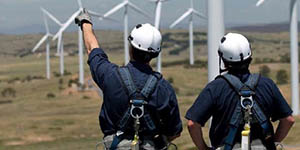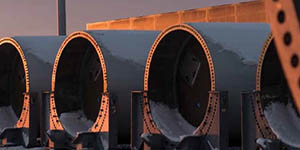As a country, Canada has prospered for more than 150 years, with one of the most diverse geographies and economies in the world. But now, with a population of more than 41 million, it is a nation that will need electricity — and lots of it — to help keep that prosperity going.
Adding to that energy challenge is Canada’s robust declaration to become carbon net-zero by 2050. It sounds like plenty of time, until you do the math — 25 years to go, and the clock is ticking.
“The federal government and many provinces have electrification goals,” said Fernando Melo, Senior Director, Federal Policy and Government Affairs with the Canadian Renewable Energy Association (CanREA). “And we have net-zero economy legislation: We are required to become net zero by 2050 — no ifs, ands, or buts. We also have a clean electricity regulation that, while very contested and undergoing some review, also requires serious investments in renewables.”

This is good news overall as the country — for the most part — is shifting into high gear to create renewable energy opportunities across Canada, according to Melo.
“CanREA is currently tracking more than 17 GW of wind energy, solar energy, and energy storage procurements across the country [1],” he said. “There are some solar-and storage-dedicated procurements, but a lot of it is wind. Wind is one of the big things provinces are looking at for their power needs, because it is affordable, reliable, and quickly scalable — all the things that energy-system operators look for. So, there’s a ton of growth coming for Canadian wind energy.”
Growing Energy Needs
And that growth is essential because the country’s energy needs will only continue to increase in the coming decades, according to Melo.
“Look at the top three population centers in Canada — Ontario, Quebec, and British Columbia — they know they need more power, and they are committing to generating it,” he said.
Whether a province’s population is big or small doesn’t seem to matter in the long run, according to Melo.
“Every other province is looking for more power as well,” he said. “The province of Manitoba, with just over a million and a half people, is committing to long-term investments. Currently, it’s only procuring 600 MW, but it’s committing to a regular cadence for more procurements. Canada’s Atlantic provinces are also committing to regular cadences and looking for those investments. Even in our smallest province, Prince Edward Island, I wouldn’t say there is going to be a massive boom, but they’re still looking for more renewable energy. Really, the entire country is open for the development of new renewable energy projects to some degree, but if a developer is looking for the hottest, most competitive markets with the highest demand right now, they are looking at Quebec, Ontario, and British Columbia.”
Political Challenges
Canada’s path to a clean-energy future has not been smooth sailing, with some regulatory, legislative and political barriers in recent years.
The federal Clean Economy Investment Tax Credits (ITCs) are a good example. Intended to accelerate investment in the low-carbon technologies Canada needs to build a net-zero economy, the concept of ITCs was introduced in 2023 by the Trudeau Liberal government, and the first few — including the Clean Technology ITC, which is aimed at private sector investment in renewable energy — were passed into law in 2024. But then, the second tranche of ITCs had their enabling legislation stalled in parliament. The Conservative Party of Canada ran a filibuster for the entire fall legislative session last year, then Prime Minister Justin Trudeau resigned, prompting a Liberal leadership race which saw Prime Minister Mark Carney selected, and he called a federal election in the spring. As a result, few advancements in the ITCs have happened within the last year, according to Melo.
“We now have some — not all — of the investment tax credits in place, and we’re already seeing a massive effect as clean energy investment-drivers,” he said. “We’re seeing the ITCs come through for private sector investments, because projects in Canada are suddenly more affordable, and investors can actually benefit from better returns. The Canadian ITCs offer a straightforward path to revenue for developers because, unlike in the United States, our investment tax credits are immediately cashable — without needing to monetize them.”
The silver lining to last year’s political disruptions has been that the new Prime Minister Carney’s Liberal government has brought a more business-focused and practical approach to governing, according to Melo.
“The Liberal Party of Canada still shares the same base, with the same commitment to the environment and to Indigenous reconciliation as before,” he said. “But Prime Minister Carney has run Fortune 500 companies. He wants to get things done, and he’s moved quickly with a lot of things and used some parliamentary maneuvers to do just that. There’s a drive to get important things done quickly, because the new government sees Canada as needing a shot in the arm to seize on its competitive advantage and ensure a prosperous economy for the future.”
Supply Chain Diversity
The unfortunate truth is that there are going to be some obstacles in the pathway of every positive change, and Melo sees supply chain issues and the recent tariff battles as definite challenges to renewables progress.
“As an organization, CanREA represents the wind, solar, and energy storage industries,” he said. “Two of those industries have a more concentrated supply chain, with many components mostly coming from China. In the wind sector, we have a more diversified supply chain, but even in the wind industry, we have a lot of componentry coming from China. And if I’m being honest, we were hoping to have the U.S. ramp up their production capacity, to be counted on for a diverse, stable, reliable, and secure supply chain, but these things are currently in question.”

Indigenous Reconciliation Commitment
One of the more fascinating aspects of how Canada is guiding renewable projects through the pipeline is in its relationship with Indigenous communities, according to Melo.
“Canada’s federal government now has a firm commitment to reconciliation with Indigenous peoples — that is, the First Nations, Métis, and Inuit peoples who have traditional rights and are title holders of the land,” he said.
Canada has made many positive strides to rectify policies that have harmed Indigenous communities in the past. New policies advancing reconciliation are now firmly entrenched in the planning of renewable projects across the country.
Indigenous communities have been forming partnerships with the Canadian renewable energy industry since the 1990s, where it became an industry norm that was codified and required as a means of economic reconciliation, according to Melo.
“Practices have been put in place to ensure that Indigenous communities benefit from and have a say in what’s being done on their land,” he said. “Different provinces have different takes on it, and different approaches. The federal government has mandated similar approaches. As CanREA, we are strong proponents of that: We think it is not just the right thing to do, but it is now just the way you do business in this country. If you’re developing projects in Canada, you need to work respectfully with Indigenous rights and title holders.”
Electricity Transformation Canada
How can the renewable energy and energy-storage industry best work with Canada’s Indigenous communities? This is just one of many subjects that will be addressed and discussed at the Electricity Transformation Canada tradeshow in Toronto, Ontario, October 6-8.
“We will have a couple of panels on Indigenous issues, with some great Indigenous leaders who are making changes within the renewable energy space,” Melo said. “Earlier this year, CanREA co-hosted a renewable energy 101 with Manitoba’s First Nations and Métis communities to help them meet developers and get to understand the industry. One of the really great things to come out of that event is that First Nations development corporations, Métis corporations, and Inuit community groups are actually coming down to Toronto for ETC and to participate in the Indigenous Pavillion. It’s something we, as an organization, really strive to create the space for.”
Another key subject for ETC attendees to discover is Canada’s investment tax credits, according to Melo.
“We’ll be talking about my favorite policies, the investment tax credits: There’s going to be a lot of discussion on that in our panels at ETC,” he said. “We’re working to get ministers from federal and provincial governments here to talk about their plans for our industry and all that entails. We will have conversations on everything from wildlife management to Canada’s vision for renewable energy, and we will hear from political actors to spell it all out clearly.”

For those reasons and many more, Melo said, it’s important for anyone wanting to know how renewables are planned, built, and run in Canada to attend Electricity Transformation Canada. “If you want to understand what’s happening in the industry and what’s going on across Canada, ETC is it,” he said. “There will be CanREA policy directors from coast-to-coast presenting and wandering around, ready to chat with anyone who wants to talk public policy with those in the know. And there will be hundreds more experts on site, representing every aspect of Canada’s clean-energy industry. If you want to talk to your competition, if you want to meet vendors, and if you want to understand the issues, whether you’re looking to invest in Canada for the first time or wanting to get involved in a more serious way, ETC is where you can get a clear snapshot of what’s going on.”
What lies ahead
Canada’s continuing path to a zero-carbon future is a challenging one to be sure, but it’s also an exciting one with a massive potential. Melo said as long as the industry can successfully work with a government that sees all the benefits renewable energy can offer, then that’s half the battle.
“We need to address the fact that we need Canada to have prosperity, and we need electricity to reach that prosperity,” he said. “Canada’s prosperity isn’t just measured in dollars and cents but also in how we protect our communities and environments from climate change — and guess what? Renewables are a great way to get there.”
More info electricity-transformation.ca
























